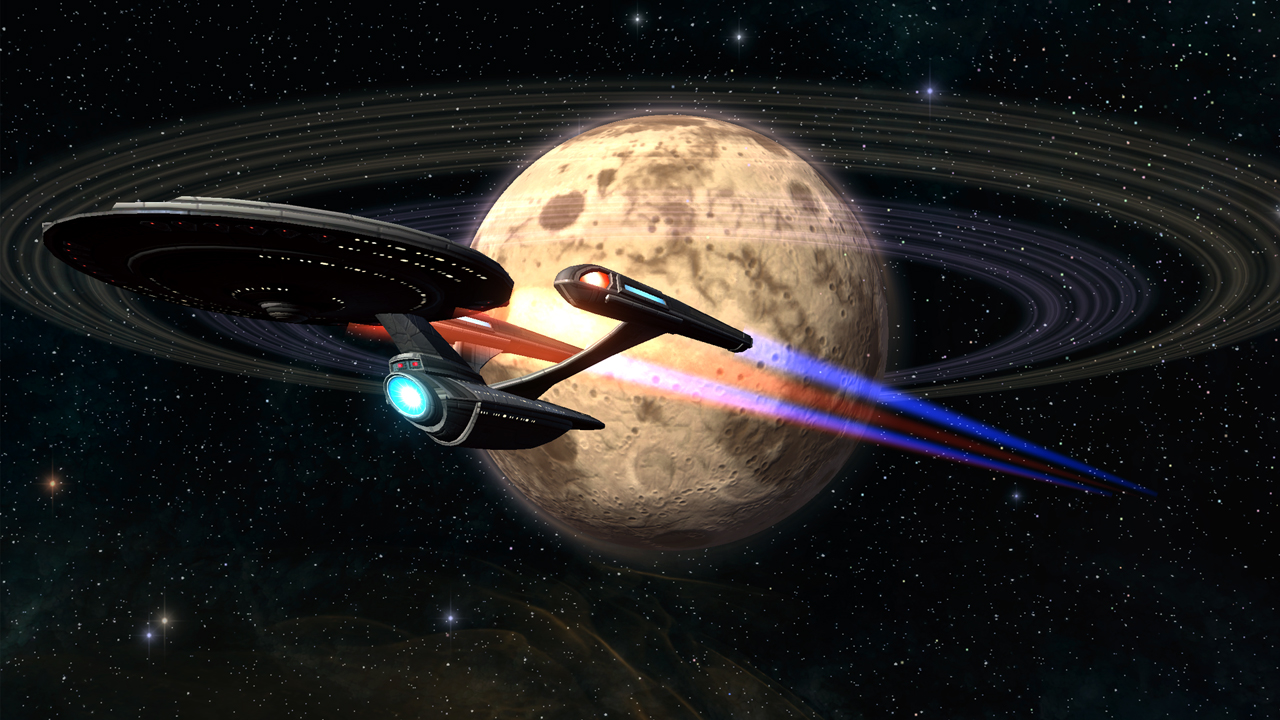Star Trek is perhaps the most enduring franchise in the history of television, having a fandom that spans multiple generations and is spread around the world. The franchise is particularly well suited to an MMO then in Star Trek Online, as consumers can enjoy the series they so love anywhere they have a reasonably recent PC. Now, with the switch over to free-to-play, Star Trek Online has become a vibrant community that’s widely accessible to people who might be interested in the game’s storyline, want to slug it out in the 3D space combat or perhaps just talk about their fandom with others who share their passion.
Cryptic Studios recently launched the largest content addition to Star Trek Online since the game switched over to free-to-play in Season 6, adding a whole slew of new things for the game’s guilds (called fleets) to do. With the shifting nature of the MMO business, it was a perfect time to talk to Star Trek Online executive producer Dan Stahl and Perfect World Entertainment vice president of business development and corporate communications John Young about the game and free-to-play in general.
Was there a feeling when Perfect World was kicking the tires of Cryptic that Star Trek Online could be the company’s crown jewel game for North America and Europe?
John Young: We saw that capability in the team that delivers Star Trek Online. We saw the potential of Star Trek Online to be huge. We come from free-to-play roots; we have 10 games right now, two from Cryptic — both of their titles we thought, “This might be good for free-to-play.”
Talk to me about taking Star Trek Online free-to-play.
Dan Stahl: I’ve been thinking about this a lot because it’s sort of appropriate to the business world. What does it mean to take a game F2P The best analogy is subscription games are like amusement parks where revenue is based on the quality fun of your attractions. STO believes the move to F2P is akin to shifting focus away from charging for admission and instead focusing on the retail business inside the park.
In our model, new attractions should not be walled off behind pay gates. This is akin to Disneyland opening up the gates for anyone to enter, but then having a cover charge to enter Tomorrow land, all you’ve done is get people further inside the park, but without a retail business, you are still dependent on the attractions for revenue. STO has focused on retail as the business and made all the attractions free. This means we can focus on building attractions that players enjoy riding over and over again, for free.
If you spend all of your capital on an amusement ride, you’re spending significant resources and limiting profitability. Consider that 67 percent of Disney’s total capital expenditure in 2009 was on new rides and you can see why ticket prices continue to climb. If you’re in a subscription model, you most likely need to sell a game expansion in order to break even or increase revenue. In our model, we can continue to release big Free Updates and avoid the need to charge for the content by capturing the in game retail opportunities in the parts of the game that supplement the big new ride. This keeps money conscious consumers happy while providing the revenue to continually add more content to the game.
Has the duty officer system [assignments for minor crew members akin to a card game] worked out well for you all and what do you say to those who think free-to-play games are really “pay-to-win”?
Dan Stahl: This is why the concept of time versus money is part and parcel to a game like STO. We specifically introduced a feature called the “Dilithium Currency Exchange” so that players with lots of time [for the duty officer system, Red Alerts, timed events and more] and no money can play the game and earn “time currency” which can then be traded to other players for “money”. No one is forced to buy anything in our game, and if you really want something from the retail store, then you can trade some of the time you’ve spent playing the game to another player for the store item you want. We have close to a million trades like this happening every day. It negates the argument that you have to have money. You can obtain nearly everything in the retail store by simply playing the game and using the in game exchange to buy what you want.
Speaking of free-to-play, what would your advice have been to Electronic Arts in the months leading up to the launch of Star Wars: The Old Republic? Would you have advised them then to try and launch with free-to-play?
Dan Stahl: Boy, I don’t know if I would have launched SWTOR free-to-play. Since I only know details that are in the public domain, it’s hard to comment. My speculation would be that when you have such a big production, presumably close to a major big budget movie, that’s a lot of money and years of development that needs to be accounted for. For such a quality production, selling a box at retail can net a big return. So should they haven’t launch F2P Hard to say if that would have been better.
Here is the challenge of Free-to-Play — it is a steadily growing business. It’s not the sort of big bang you get from a retail release. If you’ve built your game for subscriptions with those big expensive attractions, you rely on your ticket prices to cover your capital costs. It isn’t easy to retrofit a subscription game into a retail business if it wasn’t in the business plan to begin with. So I can understand why they released SWTOR as a subscription game and why I empathize with the challenge they will face as they convert over to F2P.
John Young: I want to mention with the use of a subscription model, sometimes that decision goes to the marketing department. In free-to-play, it shifts to the designers and the managers and they get to be involved with decisions that will make the game more profitable.
Dan Stahl: In a retail business everything depends on keeping traffic flowing into the game by offering big new free updates at a consistent pace. It also means having a steady pace of new items in the store to capitalize on that traffic. The amount of effort it takes release both types of content at a rapid pace is challenging and something that Star Trek Online is constantly trying to improve. We’ve struggled with this in the past and it is one of our top production goals as we move into the future — lots of new free content and lots of new items in the store at a consistent pace. When you achieve this, you not only begin to increase traffic into the game, but also increase revenue and create a positive snowball effect allowing for more investment in the game. This is how STO is growing from a small team into a much larger one capable of delivering even more content and features in the future.

I’ve heard reports that Cryptic is a very lean company — down to about 20 when Atari was looking to sell you, but you’ve staffed up more recently.
Dan Stahl: Cryptic Studios is an amazing place. Even with a smaller staff, we’ve been able to release some of the top MMOs in the industry. For example, the amount of staff we’ve had on STO has varied down to as few as 21 developers over the last year. One thing to consider is that when we say developers, it is a mix of disciplines including software developers, content designers, systems designers, audio, animators, QA, artists, and production. So when trying to build updates for the game with that size of staff, there are only a few people building the content that players are so eager to have more of.
Luckily we’ve received some great support from Perfect World, and thanks to F2P it has allowed us slow and steady growth to increase our staff to nearly twice what it was last year — and we’re still hiring! Yet, when you compare the STO Dev Team to other teams that might have anywhere from 100-300 people, it is clear that we are much more lean and mean. We control costs and stay focused by staying within budget. We keep our staff sizing directly related to the performance of the game and don’t have to be concerned about losing or laying off the amazing talent we’ve developed over the years. Even now, most of the core team on STO has been with the game since the beginning. We love this game.
Right now, your second major faction in the game, the Klingon Empire, aren’t immediately accessible. Is Cryptic seriously considering options to make the Klingons playable for starting players eventually?
Dan Stahl: We have several plans on the table to solve the issue. One of our long term goals is to make the Klingon faction available earlier; right now, a player has to play a Federation character halfway to the level cap. Solving this issue is one of the primary focuses that brought me back to the project as executive producer. It is one of my goals to get both factions on par.
It will eventually happen, but as we’ve discussed, it’s all about development budgets. We do pride ourselves on being a lean studio, but that means we have to prioritize how we spend our time. When we launched F2P, there were many lessons that we learned right out of the gate and it required the business to react quickly in order to capitalize. As we’ve made our plays and improved the game, we now have the resources necessary to move on to bigger challenges and focus on future growth.
Check back soom for the second part of the interview!

